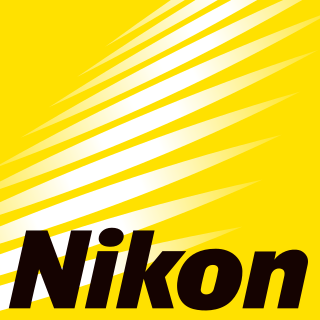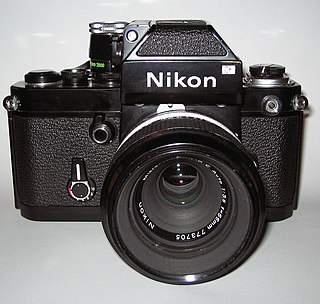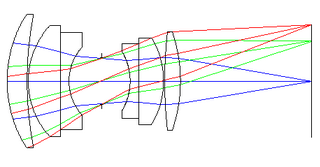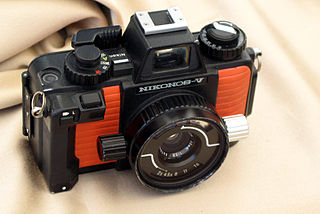

Noct is Nikon's trademark for its largest-aperture camera lenses: [1] the Noct-Nikkor 58mm f/1.2 lens produced from 1977 to 1997 and the Z mount 58mm f/0.95 S Noct introduced in 2018. [2] [3]


Noct is Nikon's trademark for its largest-aperture camera lenses: [1] the Noct-Nikkor 58mm f/1.2 lens produced from 1977 to 1997 and the Z mount 58mm f/0.95 S Noct introduced in 2018. [2] [3]

In photography, bokeh is the aesthetic quality of the blur produced in out-of-focus parts of an image, whether foreground or background or both. It is created by using a wide aperture lens.

Nikkor is the brand of lenses produced by Nikon Corporation, including camera lenses for the Nikon F-mount and more recently, for the Nikon Z line of mirrorless cameras.

Nikon Corporation is a Japanese optics and photographic equipment manufacturer. Nikon's products include cameras, camera lenses, binoculars, microscopes, ophthalmic lenses, measurement instruments, rifle scopes, spotting scopes, and equipment related to semiconductor fabrication, such as steppers used in the photolithography steps of such manufacturing. Nikon is the world's second largest manufacturer of such equipment.

The Nikon FE is an advanced semi-professional level, interchangeable lens, 35 mm film, single-lens reflex (SLR) camera. It was manufactured by Nikon in Japan from 1978 to 1983, and was available new from dealer stock until c. 1984. The FE uses a metal-bladed, vertical-travel focal plane shutter with a speed range of 8 to 1/1000 second, plus Bulb, and flash X-sync of 1/125th second. It had dimensions of 89.5 millimetres (3.52 in) height, 142 mm (5.6 in) width, 57.5 mm (2.26 in) depth and 590 grams (21 oz) weight. It was available in two colors: black with chrome trim and all black. As on the FM, its model designation did not appear on the front of the camera, but was engraved as a small "FE" preceding the serial number on the rear of the housing.

The NikonD50 is a 6.1-megapixel entry-level digital single-lens reflex camera, sold from June 2005 until November 2006 by Nikon. It was Nikon's first DSLR aimed at the consumer market, and sold for US$899. It uses the Nikon F mount. The D50 is similar to the slightly older D70 using the same CCD sensor, with a slower maximum shutter speed and slightly smaller size. However, it continued to offer the internal focus motor of prior autofocus film and digital SLRs; making it suitable for the use of autofocus with late film-era Nikkor AF and AF-D lenses. Future entry-level Nikon DSLRs would eliminate the internal focus motor and require these motors to be in the lenses.

The Nikon F-mount is a type of interchangeable lens mount developed by Nikon for its 35mm format single-lens reflex cameras. The F-mount was first introduced on the Nikon F camera in 1959, and features a three-lug bayonet mount with a 44 mm throat and a flange to focal plane distance of 46.5 mm. The company continues, with the 2020 D6 model, to use variations of the same lens mount specification for its film and digital SLR cameras.

The Nikon F2 is a professional-level, interchangeable lens, 35 mm film, single-lens reflex (SLR) camera. It was manufactured by the Japanese optics company Nippon Kogaku K. K. in Japan from September 1971 to 1980. It used a horizontal-travel focal plane shutter with titanium shutter curtains and a speed range of 1 to 1/2000 second plus Bulb and Time, and flash X-sync of 1/80 second. It had dimensions of 98 mm height, 152.5 mm width, 65 mm depth and 730 g weight. It was available in two colors: black with chrome trim and all black. The F2 was adopted by both casual photographers and professional photographers, the latter of those especially photojournalists covering the later half of the Vietnam War.

The double Gauss lens is a compound lens used mostly in camera lenses that reduces optical aberrations over a large focal plane.

Nikonos is the brand name of a series of 35mm format cameras specifically designed for underwater photography launched by Nikon in 1963. The early Nikonos cameras were improvements of the Calypso camera, which was an original design by Jacques-Yves Cousteau and Belgian engineer Jean de Wouters. It was produced in France by La Spirotechnique until the design was acquired by Nikon to become the Nikonos. The Nikonos system was immensely popular with both amateur and professional underwater photographers. Its compact design, ease of use, and excellent optical quality set the standard for several decades of underwater imaging. Nikon ceased development and manufacture of new Nikonos cameras in 2001, but the camera remains popular, and there is a large and active secondary market.

The Nikon DX format is an alternative name used by Nikon corporation for APS-C image sensor format being approximately 24x16 mm. Its dimensions are about 2⁄3 those of the 35mm format. The format was created by Nikon for its digital SLR cameras, many of which are equipped with DX-sized sensors. DX format is very similar in size to sensors from Pentax, Sony and other camera manufacturers. All are referred to as APS-C, including the Canon cameras with a slightly smaller sensor.

Lens speed is the maximum aperture diameter, or minimum f-number, of a photographic lens. A lens with a larger than average maximum aperture is called a "fast lens" because it can achieve the same exposure as an average lens with a faster shutter speed. Conversely, a smaller maximum aperture is "slow" because it delivers less light intensity and requires a slower (longer) shutter speed.

The Nikon D3100 is a 14.2-megapixel DX format DSLR Nikon F-mount camera announced by Nikon on August 19, 2010. It replaced the D3000 as Nikon's entry level DSLR. It introduced Nikon's new EXPEED 2 image processor and was the first Nikon DSLR featuring full high-definition video recording with full-time autofocus and H.264 compression, instead of Motion JPEG compression. It was also the first Nikon DSLR to provide high-definition video recording at more than one frame rate.

The Nikon 1-mount is a type of interchangeable lens mount developed by Nikon for its Nikon CX format mirrorless interchangeable-lens cameras. The 1-mount was first introduced on the Nikon 1 series in 2011, and features a bayonet mount.
The Nikon 1 J2 is a Nikon 1 series high-speed mirrorless interchangeable-lens camera launched by Nikon. Nikon lists the estimated selling price of the Nikon 1 J2 One-Lens Kit in the United States at $549.95. This kit comes with the 1 NIKKOR VR 10-30mm f/3.5-5.6 lens.

Nikon Z-mount is an interchangeable lens mount developed by Nikon for its mirrorless digital cameras. In late 2018, Nikon released two cameras that use this mount, the full-frame Nikon Z7 and Nikon Z6. In late 2019 Nikon announced their first Z-mount camera with an APS-C sensor, the Nikon Z50. In July 2020 the entry-level full-frame Z5 was introduced. In October 2020, Nikon announced the Nikon Z6II and Nikon Z7II, which succeed the Z6 and Z7, respectively. The APS-C lineup was expanded in July 2021, with the introduction of the retro styled Nikon Zfc, and in October 2021, Nikon unveiled the Nikon Z9, which effectively succeeds the brand's flagship D6 DSLR. The APS-C lineup was further expanded with the Nikon Z30, announced at the end of June 2022. The Nikon Z6III was announced in June 2024. In November 2024, Nikon announced the Z50II, the first APS-C camera to use the Expeed 7 processor introduced with the Z9.

The Nikon Z7 is a 45.7 megapixel full-frame mirrorless interchangeable-lens camera produced by Nikon. The camera was officially announced on August 23, 2018, for release in September 2018. It was the first camera to use Nikon's new Z-mount system; the second model, released in November 2018, was the 24.5 megapixel Nikon Z 6.

The Nikon Z6 is a full-frame mirrorless interchangeable-lens camera produced by Nikon. The camera was officially announced on August 23, 2018, to be released in November. Nikon began shipping the Z6 to retailers on November 16, 2018. This was the second camera to use Nikon's new Z-mount system after the release of the 45.75 megapixel Nikon Z 7 in September 2018.

The Nikon Z 9 is a full-frame mirrorless camera produced by Nikon. The camera was announced on October 28, 2021.
The Nikon Nikkor Z 58 mm f/0.95 S Noct is a full-frame prime lens manufactured by Nikon for use on Nikon Z-mount mirrorless cameras. It is one of the two Nikkor lenses that have the Noct branding, due to its very large aperture of f/0.95.